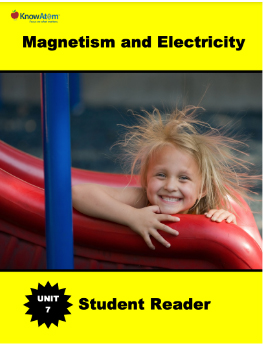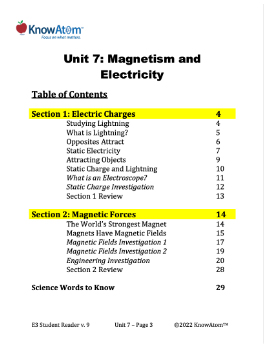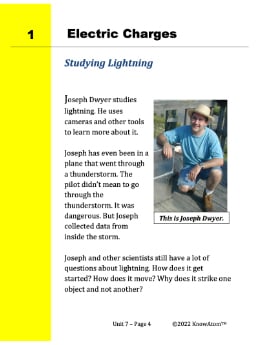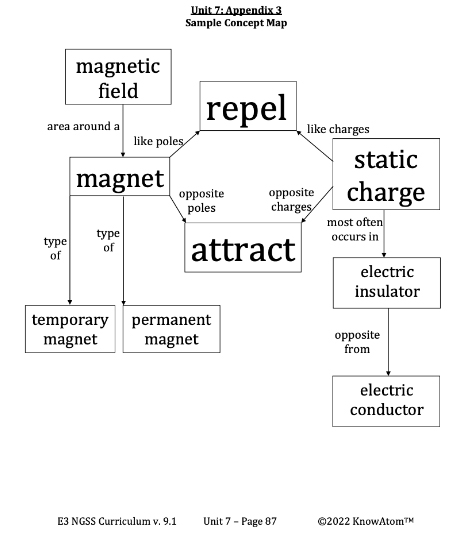Students continue to explore attractive and repulsive forces, focusing in this lesson on magnets. Students use iron filings to visualize the magnetic field interactions of permanent magnets and then test different-sized magnets.
In this unit, students explore the science phenomenon of how materials can attract or repel other materials without touching them. In this lesson, they investigate how magnets can attract or repel certain objects within their magnetic field. This page highlights the key components of this lesson.
This science background gives teachers more in-depth information about the phenomena students study in this unit. The following is an excerpt from a lesson on attraction, repulsion, and magnetism.
A magnet is any object that produces a magnetic field— the area around a magnet that attracts or repels other magnets and magnetic materials such as iron. The magnetic field occurs because all magnets have two magnetic poles: a north pole and a south pole. A pole is an area of a magnet where magnetism is concentrated. The magnetic field originates at the north pole, does a loop, and then returns to the magnet’s south pole.
The rules of magnetism are similar to the rules of electric charge: opposite poles attract and like poles repel. This means that the north pole of one magnet always attracts the south pole of another, but two north poles or two south poles always repel.
Magnetism is caused by electrons. In non-magnets, electrons randomly spin in their orbital shells. In contrast, groups of electrons in magnets spin in the same direction. The locations of a magnet’s north pole and south pole are determined by which direction its electrons are spinning. Objects such as paperclips become temporarily magnetized because their electrons spin uniformly in the presence of a magnetic field.
Magnets are useful because they can attract or repel other magnets or magnetic materials without coming into contact with the other object. A magnet in motion can also generate an electric current, which is how generators function.
Students continue to explore attractive and repulsive forces, focusing in this lesson on magnets. Students use iron filings to visualize the magnetic field interactions of permanent magnets and then test different-sized magnets.

Prepared hands-on materials, full year grade-specific curriculum, and personalized live professional development designed to support mastery of current state science standards.
Misconception: All metals are attracted to magnets.
Fact: Not all metals are attracted to magnets. Iron, cobalt, and nickel are the three naturally occurring metals that are attracted to magnets.
Misconception: Larger magnets are always stronger than smaller magnets.
Fact: A magnet’s strength depends on the materials that make it up. With two magnets of the same material, the larger magnet will be stronger than the small magnet. But in magnets made up of different materials, the smaller magnet may actually be stronger than the larger magnet.
Attract : to pull together
Repel : to push apart
Magnet : an object that produces a magnetic field; has a north and south pole; attracts or repels other magnets or magnetic materials such as iron
Magnetic Field : the area around a magnet that attracts or repels other magnets and magnetic materials such as iron
Permanent Magnet : an object that stays magnetized without electricity
Temporary Magnet : an object that acts like a permanent magnet when it is within a strong magnetic field
The World’s Strongest Magnet
The world’s strongest magnet is in Florida. It took 10 years to build this magnet. It is 6.7 meters (22 feet) tall.
Scientists from around the world come to Florida for the magnet. They carry out experiments that use the magnet. Most scientists stay for a week. Andreas Neubauer is a scientist from Germany. He stayed for six months.
Engineers have designed new types of materials with the help of the magnet. This is possible because matter acts differently inside a powerful magnetic field.
Magnets Have Magnetic Fields
A magnet is any object that produces a magnetic field. A magnetic field is the area around a magnet that attracts or repels other magnets or magnetic materials such as iron.
A magnetic field applies a force to other magnets or magnetic materials within it. This force can be a push or a pull.
All magnets have a north pole and a south pole. The north pole of one magnet always attracts the south pole of another. This is a pulling force.
However, two north poles will always repel each other. Two south poles will also repel each other. These are pushing forces.
Magnets are useful. They can attract or repel magnets or magnetic materials without touching them.
But objects are only affected by a magnet within its magnetic field. A magnet’s magnetic field is invisible. It moves from the magnet’s north pole to its south pole.
Stronger magnets have a larger magnetic field. A magnet’s strength depends on its material. There are different kinds of magnets depending on their properties.
Permanent magnets stay magnetized without electricity. Refrigerator magnets are permanent magnets.
Temporary magnets act like a permanent magnet when they are within a strong magnetic field. They lose their magnetism when the magnetic field goes away. Paperclips and iron nails are temporary magnets.



As the hands-on activity in this lesson, students use iron filings to visualize the magnetic field interactions of permanent magnets and then test magnets of different sizes. This lesson has two investigations. In the first investigation, students create visual models of the magnetic fields of attracting and repelling magnets. In the second investigation, students the relationship between the size of a magnet and its magnetic field. Students data on the magnetic fields and use this data they gathered in their investigations to construct an explanation about how magnetic forces act on different objects.
KnowAtom incorporates formative and summative assessments designed to make students thinking visible for deeper student-centered learning.

Standards citation: NGSS Lead States. 2013. Next Generation Science Standards: For States, By States. Washington, DC: The National Academies Press. Neither WestEd nor the lead states and partners that developed the Next Generation Science Standards were involved in the production of this product, and do not endorse it.
